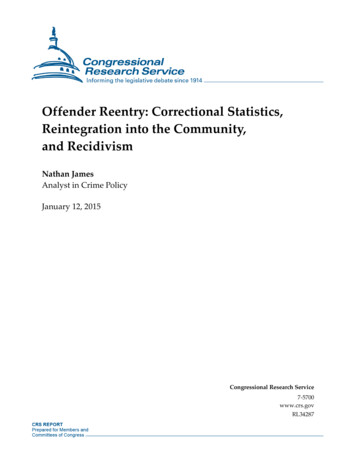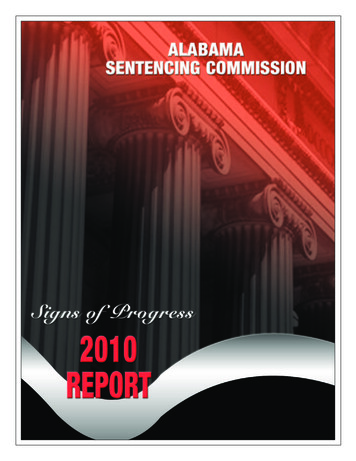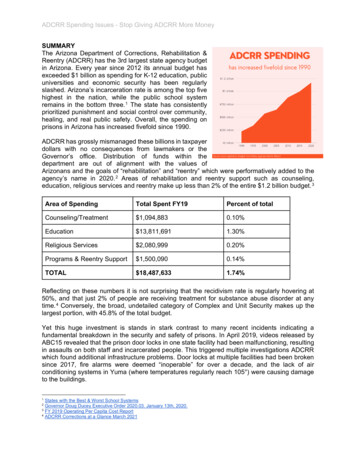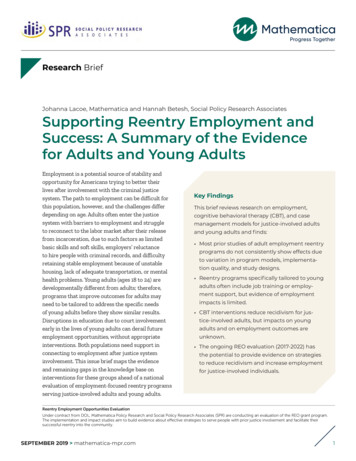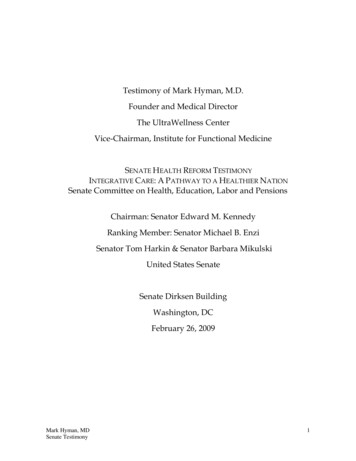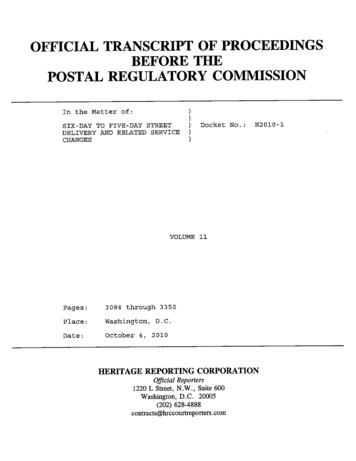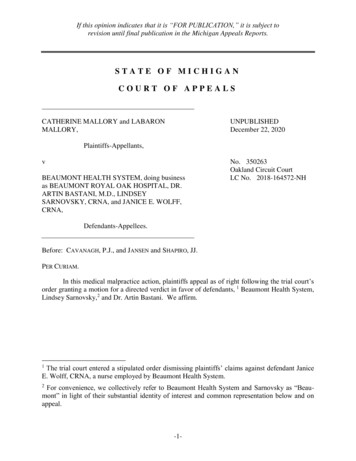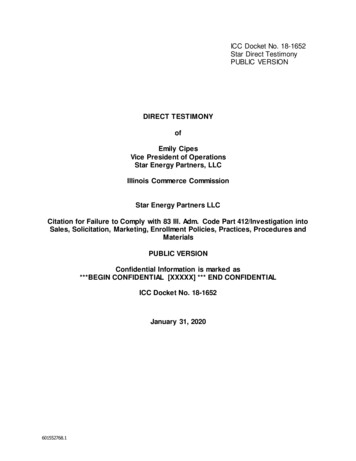
Transcription
Testimony of Jesse WiesePrison FellowshipBefore the House Judiciary Subcommittee on Crime, Terrorism, and Homeland SecurityFebruary 27, 2020Prison Fellowship is the nation’s largest Christian nonprofit serving prisoners, former prisoners,and their families, and a leading advocate for criminal justice reform. The organization wasfounded in 1976 by Charles Colson, a former aide to President Nixon who served a seven-monthsentence for a Watergate-related crime. For over 40 years, Prison Fellowship has shared hope andpurpose with men and women in prison. Those who once broke the law are transformed andmobilized to serve their community, replacing the cycle of crime with a cycle of renewal.Our prison events, classes, and programs reach more than 375,000 prisoners each year. We haveover 11,200 Prison Fellowship volunteers across the United States who make it possible to servepeople in prison and more than 300,000 children of incarcerated parents annually. One hundredand thirty federal prisons participate in our Angel Tree program and several federal prisons havePrison Fellowship connection classes, which include Bible studies, recovery groups, and seminarson topics covering marriage, anger management, and more.FACING OUR REENTRY CRISISPrison Fellowship commends this subcommittee for highlighting the failure of our society toprovide a realistic pathway for those walking out of the criminal justice system. In its simplestform, reentry is about a return to full citizenship. Ideally, this pathway ends with those on thatpath being afforded the same rights and opportunities as every American citizen. Any exceptionsto this end goal must be grounded in due process and have a clear, demonstrated relationship topublic safety. Today, that pathway, at least by way of structure, does not exist in any clear,straight-forward way for formerly incarcerated men and women. Success stories, including myown, are primarily the result of grit, self-determination, the kindness of others, and, frankly,beating the odds. Success stories are the exception, not the rule1 and apart from a pardon, evensuccess stories remain rife with arbitrary and punitive barriers. Both the federal government andstates are moving beyond the “lock-em-up and throw away the key” era, but reentry policycontinues to yield ineffective results, creating an opportunity for significant reform. To pave asystemic pathway to reentry, it takes hard work and dedication on the part of the individual and ittakes acceptance and emancipation from the community—reentry is a two-way street. Tosuccessfully pave this two-way street, it is critical to understand and address two issues: prisonculture and collateral consequences.BUILDING A REENTRY PATHWAY IN PRISON: CHANGING PRISON CULTURETypically, “reentry” is understood to be the transitional timeframe from walking out of prison andassimilating back into the community. While this timeframe is crucial, as most people return tothe criminal justice system within the first year of release,2 it is an incomplete view of reentry.1Mariel Alper & Matthew R. Durose, 2018 Update on Prisoner Recidivism: A 9-Year Follow-up Period (2005-2014), Bureau ofJustice Statistics (May 2018), .pdf.2Id.1
While many are familiar with the statistic that each year more than 600,000 state and federalprisoners come home to our communities,3 what many don’t know or understand is that most, ifnot all, were subjected to a prison culture with norms that are antithetical to the norms of success.Prison culture generally applauds values such as dishonesty and distrust, and this culture plays asignificant role in reentry outcomes. Questions like, “How are people spending their time inprison?” and, perhaps more importantly, “How are people able to spend their time in prison?” arecritical when considering a successful transition back into society. The habits and values a personpractices in prison will be their same habits when reentering. We cannot expect that crossing thethreshold of the prison gates back into the community magically eliminates the anti-social attitudesand behaviors that are prevalent within the culture of prison. We must no longer think of reentryas a timeframe, but rather as a frame of mind. Successful reentry requires a culture shift and beginsat arrest.For over 40 years, Prison Fellowship has operated from the premise that a person’s character isnot static—it can change. In order for that change to occur, there are necessary components (orpressures) that must be present. In other words, change doesn’t occur spontaneously— it must becultivated—, and it requires intentionality. Currently, most prison environments and culturesare not conducive to producing this change. For example, we know through research that learningbest occurs in a transparent and trust-centric environment, but these characteristics are theantithesis of prison culture. We also know that the more observations and interactions that peoplehave of role models, the more likely they are to emulate and adopt those behaviors and attitudes—change is more “caught” than “taught”. Sadly, positive examples are also not a constantoccurrence in prison culture. Lastly, research supports the adage that “practice makes perfect.”The more frequently people practice positive behaviors, the more likely they are to adopt them astheir own, yet there are few purposeful opportunities in prison to practice positive behaviors.Part of the discussion on prison culture change must involve metrics. Currently, our prisonsystem’s success metrics are mostly framed by constitutional violations, violence rates, contrabandcapture rates, and recidivism. Recidivism, however, measures failure, not success. The data pointsthat are glaringly missing are related to cultural assimilation and contribution, i.e., the outcomesthat we actually want. While recidivism is certainly an important data point, it is not the primaryoutcome we should be chasing. Think about how this measurement system would work acrossother social service sectors. Would you want to go to a hospital that only posted a success metricof its death rate? While that is important, you would also want to know how many peoplerecovered and specifics to their recovery outcome. Did they go into remission, have to maintainmedication, or require ongoing medical assistance? In other words, you would want to know thehospital’s success rate related to retaining or advancing a patient’s quality of life.In the same light, why would we be satisfied with a low recidivism rate if the majority of those notreturning to prison were heavily reliant on safety net programs, addicted, or homeless? At PrisonFellowship and as a society, we want more for people coming out of prison. We want them to beengaged in civic activities; we want them to be positive public actors, invested in theircommunities and advancing a pro-social worldview in the public square. We want people to work,pay taxes, take care of their families, volunteer, and be positive catalysts in our communities.3Jennifer Bronson & E. Ann Carson, Prisoners in 2017, Bureau of Justice Statistics (April 2
We want people to be good citizens.Prison Fellowship has long recognized that prison culture is one of the leading causes of poorcriminal justice outcomes. Established in prisons across the country, the Prison FellowshipAcademy guides incarcerated men and women through a yearlong, transformational journey.Using evidence-based practices and life-changing curriculum, Academy participants develop andpractice the biblically based values of Good CitizenshipSM: responsibility, integrity, restoration,community, productivity, and affirmation. In the Academy’s healthy community environment,participants overcome the life-controlling issues that led to their incarceration. As they adopt andapply the values of Good Citizenship, they acquire new life skills and replace criminal thinkingand behaviors with a renewed value system and life purpose. Academy graduates complete theprogram as change agents, prepared to take their places as good citizens—productive and positivecontributors to their communities inside and outside of prison.The reality of prison culture has directly informed the methodology of our Academy program. Inits more intensive versions, the Prison Fellowship Academy utilizes a full-time program managerto develop and foster a pro-social community inside of prison. Prison Fellowship staffintentionally work to carve out a pro-social space for men and women to practice prosocial values.The Academy not only measures recidivism,4 but also measures the adoption of the values of GoodCitizenship.5 The Academy as well as other evidence-based programs and productive activitiesare a critical foundation to building a constructive prison culture. The First Step Act of 2018, firstpassed by the House Judiciary Committee, seeks to build this foundation, requiring that everyperson incarcerated in the Bureau of Prisons is provided with opportunities to participate inprograms that meet his or her risks and needs.The First Step Act recognizes that we can no longer afford to ignore the reality that prison cultureis a primary catalyst in poor reentry outcomes. Prison Fellowship believes that communities andtaxpayers want a better outcome from their criminal justice system and in order to see thatoutcome, prisons must first and foremost provide a place for people to practice Good Citizenship,fail, and then practice again. Once a culture of Good Citizenship is established, not onlycan personal change be cultivated, but those who are changed (and changing), become changeagents. They bring about a values-based shift within the larger prison culture and are ableto seamlessly fold into our communities, to which most of them will one day return. Withprograms like the Academy at hand, people who were once part of the problem become powerfulpieces to the solution.The criminal justice system has become a social shaper in the United States that impacts millionsof people every year. It’s time we talk about the culture of that social shaper. When I entered the4Executive Administrative Services, Evaluation of Offenders Released in Fiscal Year 2013 That Completed Rehabilitation TierPrograms, Texas Department of Criminal Justice (October 2017) (posting the Academy as the best performing program to reducethree-year recidivism); Department of Corrections, An Outcome Evaluation of the InnerChange Freedom Initiative in Minnesota,Minnesota Department of Corrections (February 2012); Byron R. Johnson & David B. Larson, The InnerChange FreedomInitiative, A Preliminary Evaluation of a Faith-Based Prison Program, Baylor University ument.php/25903.pdf.)5Thomas C. Reeves, et al., Evaluation Report: Prison Fellowship Tier-2 Academy at Kate Barnard Correctional Center (KBCC),University of Georgia (2019), iles/inline-files/Academy%20Eval%20Report%20KBCC insert web.pdf.3
criminal justice system in 1999, I was quickly confronted with prison norms. Adapting to thisculture offered some sense of short-term safety and security, yet, my journey towards GoodCitizenship was perplexing. On one hand, it was easier to just live by the “prison code,” but I knewthat if I didn’t stretch my Good Citizenship muscles, I wouldn’t be as successful upon release.However, when I tried to live by pro-social values, it put me at odds with the larger prison culture,and the risk of that action was a loss in comfort and potentially safety. When confronted with thischoice, many will take the path of least resistance and remain stuck in a place that always lookstoward “tomorrow” to start the process of change. I believe hundreds of thousands of people arestuck in this “in between,” and only by intentionally addressing the prison culture issue will weprovide true pathways to reentry—a pathway that begins with “today.”MY REENTRY JOURNEYI was twenty-one years old when I robbed a bank at gunpoint. I was sentenced to serve fifteenyears in the Iowa penal system. My actions were a result of personal despair, selfishness, andhopelessness. It caused harm to my victim, myself, the community, and my family and friends.There are few helpful hands in prison, yet I was fortunate to find a few. Through those interactions,I began to find purpose, value, and hope, and quickly realized that actions do not take place in avacuum. Crime harms people, breaks relationships, and has life-long consequences. I deeplyregretted my actions and looked forward to satisfying the debt that I owed.During my incarceration, I did my best to prepare for my opportunity at a second chance. I hadconfronted my actions, reconciled with my victim, graduated with honors with my undergraduatedegree, helped other men in prison obtain their GED, graduated from the Prison FellowshipAcademy program, spent time encouraging and challenging incarcerated adolescents, and spentthe last three months of my sentence studying for the law school admission test.I walked out of the Iowa prison system thinking two things: I wasn’t the same man walking outthat I was walking in, and I wanted to make a positive difference. I deeply wanted to expiate myguilt and prove to society that I could once again be a trusted and valued citizen.When I was released, I began to put into practice what I had been taught. I sought out mentors,engaged in the community, developed a new social network, got a job, and encouraged others todo the same. Those practices and relationships led to other opportunities. I was accepted to lawschool where I interned with a state juvenile court judge, served as president of the Honor Council,drafted statutory reforms to eradicate domestic child-sex trafficking, and graduated magna cumlaude. I passed the Virginia bar exam (twice) and joined Prison Fellowship to advance the valuesof hope and justice in the criminal justice system.Though my name may be attached to these achievements, a very small amount of the recognition,if any, should be attributed to me. The accolades belong to those along the way that sowed intothe soil of my life and believed that I could “make good” on my second chance. These are muchdeserved dividends earned on the thousands of dollars Iowa taxpayers paid for my bad decisionand the countless hours and resources several mentors gave to me along the way.4
The truth is, however, that achieving these successes was not an easy task and there are stillobstacles to overcome. I had to fight every step of the way to get where I am today. This is not tosay that it should be easy, but it is an arduous and continual process convincing landlords,universities, professional licensing boards, churches, and even criminal justice officials that thesystem can actually work, and that men and women can change with the right accountability,resources, and opportunities. I learned early that my voice and accomplishments were not enoughto erase the vestiges of a felony conviction. I pursued relationships with judges, lawyers, faithleaders, and other upstanding members of the community who often advocated on my behalf. Evenwith their voices, however, my inability to obtain a license to practice law required a decade ofperseverance that included taking and passing the Virginia bar exam for a second time, hundredsof pro-bono legal hours, six administrative hearings, and two appeals to the Virginia SupremeCourt. Despite this difficult path, I continued to challenge the men and women in our prisons toreach for the stars, dream big, and take hold of their second chance, though there were times whereI wondered if my promoting such an unattainable challenge was unethical. Many of us who havebeen in the criminal justice system have never envisioned ourselves beyond government subsidiesor a minimum-wage job. Unfortunately, even with supporting research6 and the tools and visionto achieve personal success, we often remain relegated to places of continual failure or hit a glassceiling because of arbitrary collateral consequences.After my release, I had the opportunity to assist men with basic reentry issues as they weretransitioning back into society from a period of incarceration. Time and time again, I witnessedthe majority of them give up on their dreams of success because of the second chance barriers thatclearly lay before them. The goals that we encourage men and women to set and work towardsduring their incarceration quickly become shattered when faced with the uphill battles of housing,employment, and social stigma. In most cases, giving up on these dreams did not result inrecidivism, but it did result in them accepting their place in society as second class citizens whoare unworthy of achieving certain levels of success or even representation.Earning back the public’s trust after committing a crime should not be an easy task, but it must bea realistic and attainable one if we want to increase public safety. The billions of taxpayer dollarspoured into rehabilitation programs every year amount to nothing more than a colossal waste if weas a society don’t allow the men and women walking out of prison doors to practice therehabilitation we are so adamantly preaching. In effect, we spend billions of dollars teachingincarcerated men and women how to build a new car (i.e., a new life), provide the appropriateparts, and give them the keys, but when the prison doors open, there are no roads. And where thebrave forge ahead to make their own roads, they quickly run out of gas. This proverbial “pullingthe football from Charlie Brown” approach only seeds discontent and distrust and reinforces theanti-social behaviors that many in the corrections arena are working so hard to reduce.When I walked out of the prison system, the most impactful thought I left with was that if we wantpeople in prison to succeed, we need to change the way we “do” prison in the United States. Thepathway to successful reentry begins with providing opportunities to practice Good Citizenship in6See, e.g., Alfred Blumstein & Kiminori Nakamura, ‘Redemption’ in an Era of Widespread Background Checks, NAT’L INST.JUST. J. No. 263 (June 2009), https://www.ncjrs.gov/pdffiles1/nij/226872.pdf (stating that after a certain time period, thelikelihood that a person with a prior conviction will commit another crime will diminish to that of society, thus limiting the riskof recidivism and the need for some collateral consequences).5
prison. However, as I began to pursue my second chance after my release and work with others,it became quickly evident that the reentry pathway cannot stop at the prison gate.THE PATHWAY PAST PRISON: ADDRESSING COLLATERAL CONSEQUENCESThe overuse and general acceptance of collateral consequences is cause for genuine concern.Taxpayers and victims of crime count on a return for their investment in the criminal justice systemand imposing arbitrary and perpetual civil punishments as a result of a criminal conviction greatlydiminishes that return. Under the Constitution, each reentry story begins with due process. Toprotect that formative American belief, we should apply serious scrutiny to processes that restrict“life, liberty, and the pursuit of happiness.”7 The reach of due process to limit one’s liberty,however, cannot stretch beyond the point when the punishment is paid in full. The scope oflimiting a person’s “liberty” was never meant to be applied for a lifetime or to keep people in anindefinite second prison; however, that is the reality in the criminal justice system. Most criminaldefendants are not aware of the breadth and longevity of the consequences of a guilty verdict orpleading guilty. Collateral consequences are hidden, life-limiting restrictions on personal liberty,and whether those restraints need additional due process should seriously be considered.8Even after paying their debt to society, the 70 million men and women with criminal records inAmerica continue to face systematic and often life-long barriers to second chance opportunities.After someone has completed their traditional sentence, Prison Fellowship believes onlyrestrictions to personal liberty that have a demonstrated and substantial link to protecting publicsafety should be permissible. Even in these limited cases, the restrictions should be anticipated atthe time of sentencing as part of the defendant's proportional punishment, and notification of allsuch consequences should be given to the defendant during the trial process.The term “collateral consequences” is a fairly new term referring to the “wide-range of statusrelated penalties, sanctions, and restrictions that are permitted or required by law because of acriminal conviction even if not included in the court’s sentence.”9 As this subcommittee is aware,collateral consequences include, among other limitations, the loss or restriction of employment orprofessional license, eviction from public housing, ineligibility for welfare benefits, loss of rightto hold public office, serve in the military, volunteer, or sit on a jury. Collateral consequences mayalso include the loss of parental rights, exclusion from government contracts, and the inability tolive in certain areas. Practically, the stigma associated with a criminal conviction almost alwaysresults in the permanent loss of standing within the community.Collateral consequences have been a familiar feature in the American justice system since colonialtimes and garnered some reform interest among legal scholars in the 1970s.10 Recently, however,7THE DECLARATION OF INDEPENDENCE para. 2 (U.S. 1776).See e.g., Padilla v. Kentucky, 559 U.S. 356 (2010) (finding that defense attorneys have an affirmative duty to advise clientsabout mandatory deportation consequences of a criminal conviction); People v. Hughes, 2012 I.L. 112817 (2012) (applyingPadilla disclosing requirements to involuntary civil commitment); Calvert v. State, 342 S.W.3d 477 (TN 2011) (applying Padilladisclosing requirements to lifetime supervision).9Margaret Colgate Love, et al., COLLATERAL CONSEQUENCES OF CRIMINAL CONVICTIONS: LAW, POLICY AND PRACTICE 25 (2013).10See, e.g., Margaret Colgate Love, Starting Over With a Clean Slate: In Praise of a Forgotten Section of the Model Penal Code,30 FORDHAM URB. L.J. 1705 (2002) rticle 1880&context ulj (discussing thehistory and reform trends of collateral consequences).86
there has been an increasing awareness on the issue of collateral consequences.11 The reasons forthis increased concern are likely related to the rising prison population, the ballooning of thecriminal justice system, and technological advances in providing background searches.12 Today,the Justice Center at the Council of State Governments has identified over 44,000 legal collateralconsequences in existence13 and approximately sixty-five to seventy million Americans (1 in 3adults) have a criminal conviction.14 Additionally, the expanse of the administrative governmentalagency has created a bureaucratic web making the reprieve from collateral consequences muchmore difficult to successfully navigate. In fact, one of the most misunderstood aspects of collateralconsequences is that the majority of them are not legally or statutorily imposed.15 The limitednumber of collateral consequences that are actually enforced are imposed legally throughlegislative action and are typically the most commonly known, including prohibitions on firearms,voting, serving on a jury, and holding public office. The majority of collateral consequences,however, are imposed by independent rulemaking through administrative agencies that classify acriminal conviction or a corresponding lack of “moral character” as the means for disqualificationfrom some type of governmental assistance or benefit. In addition, there is a powerful culturalelement to the stigma of a criminal conviction, which is mostly seen in the form of backgroundchecks conducted for employment, housing, and volunteer opportunities and poor use of thisinformation by decision makers.Additionally, the internet has increased access to criminal record information and the ease at whichbackground checks can be conducted. This has extended collateral consequences to simple arrests,even in instances where the case is dismissed, an individual successfully pursues a diversionprogram, or there is a not-guilty verdict. States have begun to reconcile this unjust outcome byattempting to keep arrest records confidential from public purview,16 providing certificates ofrehabilitation,17 or passing policies that automatically clear certain criminal records known asClean Slate laws.1811Justice Center, National Inventory of Collateral Consequences of Conviction, The Council of State Governments (2019),https://niccc.csgjusticecenter.org/; U.S. Commission on Civil Rights, Collateral Consequences: The Crossroads of Punishment,Redemption, and the Effects on Communities, United States Commission on Civil Rights (June eral-Consequences.pdf; NACDL, Collateral Damage: America’s Failure toForgive or Forget in the War on Crime, National Association of Criminal Defense Lawyers (May ageARoadmaptoRestoreRightsandStatus; Memorandum from Att’y Gen. EricHolder on Consideration of Collateral Consequences in Rulemaking (Aug. 12, 2013); 12U.S. Sentencing Commission on Civil Rights, supra note 12.13Justice Center, supra note 12.14Anastasia Christman & Michelle Natividad Rodriguez, Research Supports Fair Chance Policies, The National EmploymentLaw Project (August 2016), -fair-chance-policies/# edn1; Bureau of JusticeStatistics, Survey of State Criminal History Information Systems, 2010, U.S. Department of Justice (November 37253.pdf; Office of the Attorney General, The Attorney General’s Report onCriminal History Background Checks, U.S. Department of Justice (June 2006),http://www.justice.gov/olp/ag bgchecks report.pdf.15Justice Center, supra note 12.16E.g., S.B. 14-206, 69th Gen. Assem., 2d Sess. (Colorado 2014).17Information Center, Certificates of Rehabilitation, National Institute of Corrections (May erShared/2016-05-18 nic certificates of rehabilitation.pdf; Ram Subramanian, etal., Relief in Sight? States Rethink the Collateral Consequences of Criminal Conviction, 2009-2014, Vera Institute of Justice(December 2014), es-ofcriminal-conviction-2009-2014/legacy eport-v4.pdf.18Clean Slate Bill, H.B. 1419, 2018 Reg. Sess., (PA 2018); H.B. 431, 63rd Gen. Sess. (Utah 2019);7
PERVERSE FEDERAL INCENTIVES AND COLLATERAL CONSEQUENCESIn certain instances, the federal government has incentivized states to adopt collateralconsequences by withholding federal dollars if those collateral consequences are not properlyimplemented. For example, states face a reduction of federal transportation funding if they do notrevoke or suspend “for at least 6 months, [] the driver’s license of any individual who is convicted. . . of any violation of the Controlled Substances Act, or any drug offense.”19 This restriction isnot directly related to any driving offense and is a classic example of a collateral consequence thatdoes not have a nexus to the criminal conduct.Additionally, as a result of the “War on Drugs,” the federal government began to implement “useraccountability” provisions that precluded men and women with a drug conviction from certainfederal benefits. Under the Anti-Drug Abuse Act,20 these provisions denied certain federal benefitssuch as access to grants, federal student loans, and professional licenses to people convicted ofdrug offenses. In 1996, the Personal Responsibility and Work Opportunity Reconciliation Act21(the Welfare Reform Act) instituted a lifelong ban on Supplemental Nutrition Assistance Program(SNAP, formerly Food Stamps) for people convicted of drug crimes. Realizing that these postconviction sanctions did not address the drug issue, Congress eventually lessened the rigidrestrictions under the Drug Abuse Act, but the lifelong restrictions related to SNAP benefits remainin force unless state legislatures reject or modify it.22 Punishing men and women by refusing toallow them life-sustaining benefits is an immoral and regressive approach to criminal punishment.Again, instituting consequences that are not rationally related to the crime impedes public safetyand is a disproportionate response to criminal behavior.These federal examples highlight the fact that several, if not most, of collateral consequences arenot rationally related to the criminal conduct. One of the strongest examples of that disconnectinvolves victim compensation funds. State victim compensation funds are funded by criminalfines and taxpayer dollars and offer monetary assistance to victims and survivors of violent crime.Unfortunately, eleven states disqualify a victim’s ability to receive compensation if that person hasa felony conviction.23The encouraging news is that both Republicans and Democrats are beginning to see the hypocrisyin spending millions of taxpayer dollars on reentry services in one bill but creating overwhelmingobstacles with another. As former Virginia Attorney General Ken Cuccinelli stated, “If we reallybelieve no one is beyond redemption we need to stop throwing away that key.”24 Refraining fromthe arbitrary expansion of collateral consequences is a good step in that direction, and Congress isincreasingly committing to that goal. Prison Fel
straight-forward way for formerly incarcerated men and women. Success stories, including my own, are primarily the result of grit, self-determination, the kindness of others, and, frankly, beating the odds. Success stories are the exception, not the rule1 and apart from a pardon, even success stories remain rife with arbitrary and punitive .
